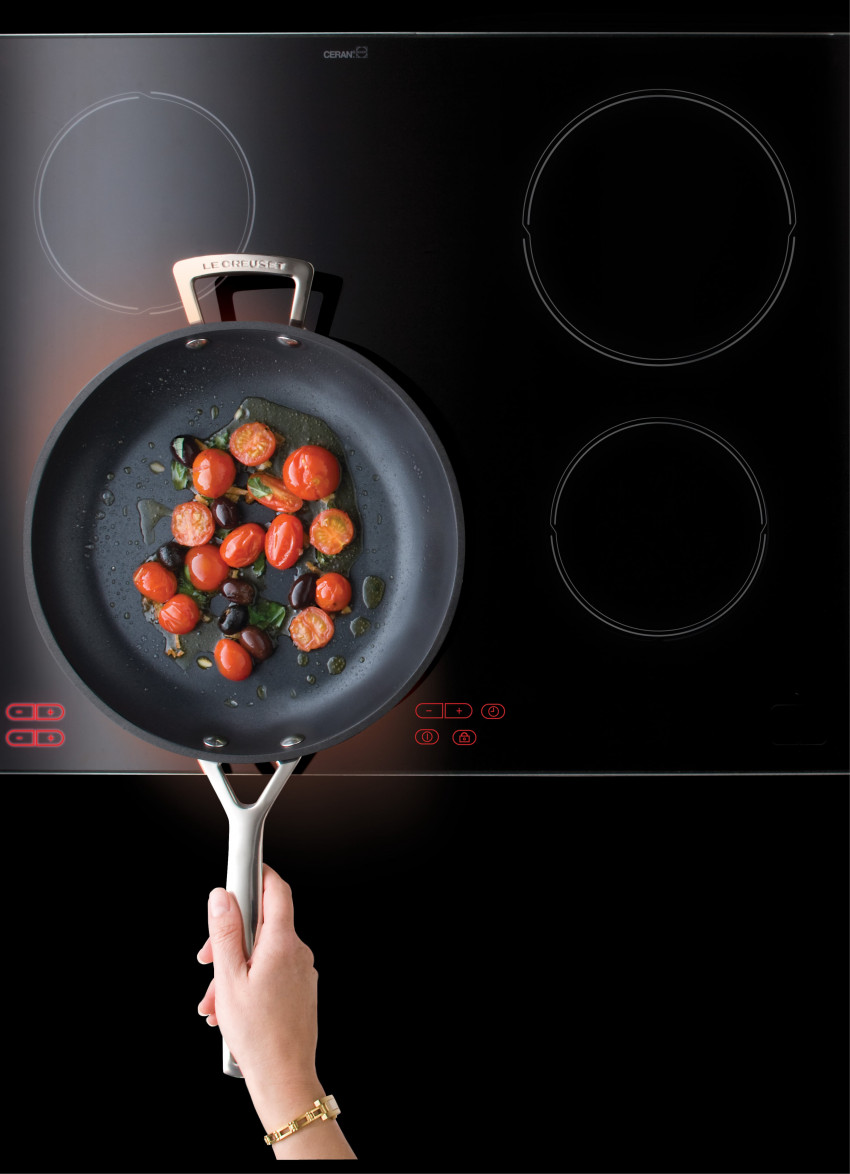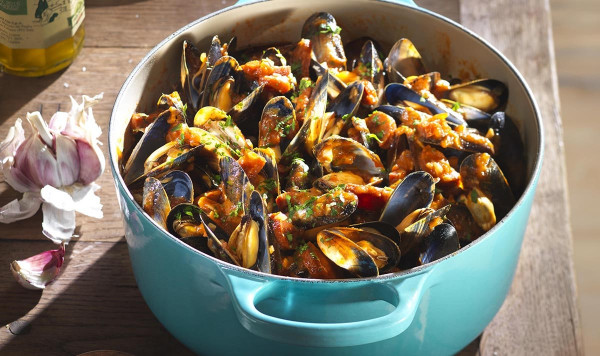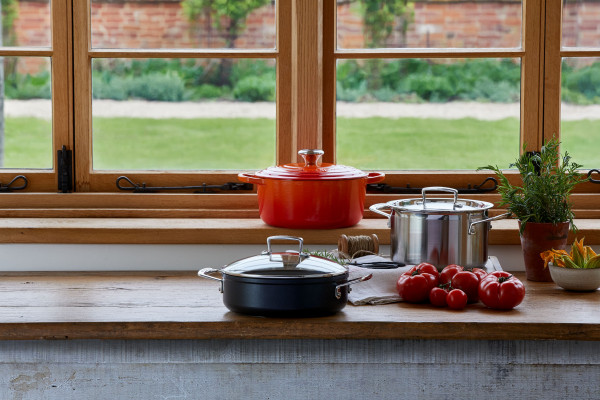Understanding Induction Cooking by Le Creuset

Induction hobs have rapidly gained popularity for their quick cooking times, precision, and energy efficiency. However, there is still a degree of confusion about how they work, so Le Creuset decided to clear up a few questions around induction cooking.
What is induction cooking?
An induction hob transfers the heat generated by magnetic energy (instead of heat from a gas flame or electric element) to the food in suitable cookware. It produces instant heat, and is known to use less power and cook faster than conventional and gas hobs.
When the induction surface comes into contact with induction-suitable cookware, it produces a magnetic field that instantly generates heat to your cookware. Heat is only generated beneath the base of the magnetic cookware, making it energy-efficient and safe.
Is Le Creuset cookware suitable for induction?
Induction hobs work well with any cookware with a high iron (ferrous metal) content at the base. Our Enamelled Cast Iron*, Stainless Steel, and Toughened Non-Stick cookware are all suitable for induction hobs, as are our enamel-on-steel kettles.
What are the benefits of induction cooking?
- It is energy efficient. Induction hobs utilise the majority of the energy they produce, for minimal heat loss.
- Cleaning your hob is quicker and easier. Because the surface of an induction cooktop stays cooler, any spills don’t burn and stick.
- It is quicker and more powerful than traditional gas or electric stovetops and will bring your food to the boil twice as fast.
Top 6 Induction Tips
1. Make sure the size is correct. The hob should not be bigger than the Le Creuset pan as this would reduce the heating performance or simply not work. It is okay if the pan is larger than the hob, but for optimal performance, match both sizes.
2. Check that the whole base makes contact with the hob (if previously used on gas and overheated, the shape may be warped, and this could prevent it from working on induction).
3. Place the Le Creuset pan carefully on the hob and always lift it on and off to prevent scratches on the induction surface.
4. Allow the hob and pan to heat together, slowly.
5. Only use the boost option for boiling water, however, avoid using the boost function with Le Creuset Enamelled Cast Iron.
6. We recommend that you cook over a low to medium heat as all Le Creuset cookware is designed to heat evenly and effectively. This will also allow for easier clean-up.
Shop Le Creuset Cast Iron, Toughened Non-Stick, 3-ply Stainless Steel and Kettles at Le Creuset Boutique in Westfield Newmarket or call +649 303 3539.
What's on the menu?
Take advantage of precision induction cooking with these delicious ideas. Our round-up features a recipe to suit every occasion and taste.
Mussels, Chorizo and Tomato Ragout on Garlic Toast

SERVES 4-6
Ingredients
200g (7oz) good quality cooking chorizo- skinned
3 tablespoons extra virgin olive oil, plus extra for serving
1 medium onion- finely chopped
5 large garlic cloves- 4 finely chopped and one left whole
½ teaspoon crushed dried chillies
1 teaspoon sweet pimenton (Spanish smoked paprika)
400g (14oz) tomatoes, fresh or from a can- skinned and chopped
1 tablespoon tomato puree
100ml (4floz) dry white wine
100ml (4floz) fish stock, chicken stock or water
3 tablespoons sherry vinegar
2 teaspoons caster sugar
1.25kg (2 ¾lb) rope grown mussels- cleaned (see cook's notes)
4x2cm (¾ inch) thick slices rustic white bread
2 tablespoons chopped flat leaf parsley
Salt and freshly ground black pepper
Method
1. Cut the chorizo in half lengthways and then across into thin slices. Put the olive oil into the Le Creuset casserole and place it over a medium heat. As soon as it is hot, add the chorizo sausage and fry for 2 minutes until lightly coloured. Stir in the onion, garlic, dried chilli and pimento. Place on the lid and cook gently for 10 minutes until the onion is very soft. Add the tomatoes, tomato puree, wine and stock or water and simmer without the lid for 10-15 minutes until it has reduced by about half.
2. Put the sherry vinegar and sugar into a small pan and boil until reduced to 2 teaspoon. Stir it into the tomato sauce and season lightly with salt and some black pepper.
3. Heat a large, ridged Le Creuset grill pan over a high heat. Whilst the grill is warming, tip the mussels into the tomato sauce, cover and cook over a high heat for 4 minutes until all the mussels have just opened. Half ways through cooking give the mussels a good stir. Meanwhile, add the slices of bread to the griddle pan and leave them to toast, pressing down lightly on them with a fish slice, until they are nicely golden and marked with the bars from the griddle. Rub one side of each slice with the remaining whole garlic clove. Place a slice in the bottom of 4 large, warmed soup plates and drizzle with a little olive oil.
4. Uncover the mussels and stir in most of the parsley, coasting the mussels with chorizo and tomato sauce as you do so. Spoon the mussels and plenty of sauce on top of the garlic toasts, sprinkle with the remaining parsley and serve straight away.
Cook's Notes
- Mussels are ideally suited to the cold winter waters of the British Isles and are at their best when there is an 'R' in the month, between September and April. During the summer months when the waters are that bit warmer, they expend all their energy during spawning, which results in poor quality meats and less flavour.
- Farmed rope grown mussels are best because they are usually of a uniform size, have thinner, cleaner shells, big fat juicy meats and open quickly at about the same time during cooking.
- Fresh mussels should just smell faintly of the sea. Most of the shells should be tightly closed when you get them, or they should close up when given a light squeeze or gentle tap on the side of the sink. They should also feel quite heavy. Stale mussels are light in comparison. Once mussels start to get old and die, they constantly open and close their shells, all the while losing their juices, which means that the cooked meats will not be as plump and juicy and they won't yield as much liquid during cooking.
- Allow between 600g (1lb 5oz) and 750g (1¾lb) of mussels per person for a main course. Transfer them to a large bowl as soon as you get them home and cover them closely with a thick layer of wet newspaper or a wet old tea towel. This will keep them alive. Use them on the same day that you buy them, unless you know they have just come from the sea; they will then last a couple of days, but no longer. When you are ready to cook them, clean them by giving them a good scrub under some cold running water, knock off any barnacles with a knife, and then pull out the 'beards' from between the tightly closed shells. Discard any that have broken shells or don't close when you tap them on the side of the sink.
Japanese Seared Tuna with Shredded Greens, Pickled Ginger and Garlic Chives

SERVES 2-4
Ingredients
MAIN
4 x 100-120g tuna steaks cut about 1cm thick
1 tablespoon groundnut or vegetable oil
25g pickled sushi ginger
A few Chinese garlic chives or ordinary chives, cut into short pieces
MARINADE
1 tablespoon mirin
1½ tablespoons Japanese soy sauce
1 teaspoon sesame oil
STIR-FRIED CHINESE GREENS
1 tablespoon groundnut oil
3 cloves garlic, finely shredded
1 small red pepper, stalk and seeds removed, then finely shredded
1 small green pepper, stalk and seeds removed, then finely shredded
1 large carrot, peeled and finely shredded
300g Chinese leaf cut into 2cm pieces
6 heads of baby bok choi (approx. 175g), quartered lengthways
1½ tablespoons oyster sauce
Method
1. Place the tuna in a dish; add the mirin, soy sauce and sesame oil. Coat the fish well, cover and leave to marinate for 20-25 minutes in a cool place.
2. Heat the groundnut oil in the Le Creuset wok and quickly stir-fry the garlic for a few seconds. Add the red and green pepper and stir-fry for 3 minutes. Add the carrot, Chinese leaf and bok choi and continue to stir-fry for 2 minutes. Swiftly stir in the oyster sauce, spoon into a serving bowl and keep warm.
3. Drain the tuna from the marinade.
4. Pre-heat* the wok on a medium heat and when hot add the tuna steaks one at a time. Cook for 1 minute until seared and beginning to blacken around the edges. Flip the fish over and sear for 1 minute on the other side, then quickly remove the fish from the wok.
5. Arrange the seared tuna on a serving plate and garnish each steak with a few pieces of pickled ginger and chives. Serve with an accompaniment of soba noodles.
Cook's Notes
- Japanese ingredients can be found in supermarkets and speciality Asian-food stores.
- Mirin is a type of sweet rice wine.
- Japanese soy sauce is a lighter, thinner version of Chinese soy sauce.
Shop Le Creuset Cast Iron, Toughened Non-Stick, 3-ply Stainless Steel and Kettles at Le Creuset Boutique in Westfield Newmarket or call +649 303 3539.
Facebook: @lecreusetanz
Instagram: @lecreusetanz
Pinterest: @lecreusetanz
latest issue:
Issue #120
As the days become shorter, and the nights cooler, the latest issue is perfectly timed to deliver delicious autumn dishes. From recipes using fresh seasonal produce such as feijoas and apples, to spectacular soothing soups and super-quick after-work meals in our Food Fast section, we’ve got you covered. With Easter on the horizon, we feature recipes that will see you through breakfast, lunch and dinner over a leisurely weekend holiday, and whip up chocolatey baking treats sure to please. We round up delicious dinners for two and showcase a hot new Korean cookbook before heading south to Dunedin to check out all that’s new in food and dining.The latest issue of dish is on sale NOW at all good bookstores and supermarkets – don’t miss it!


